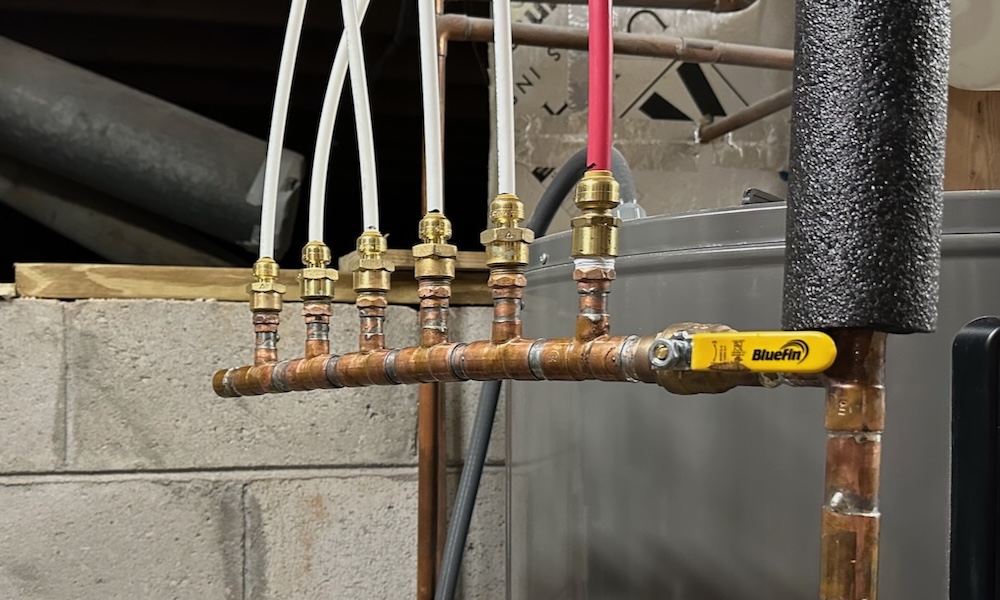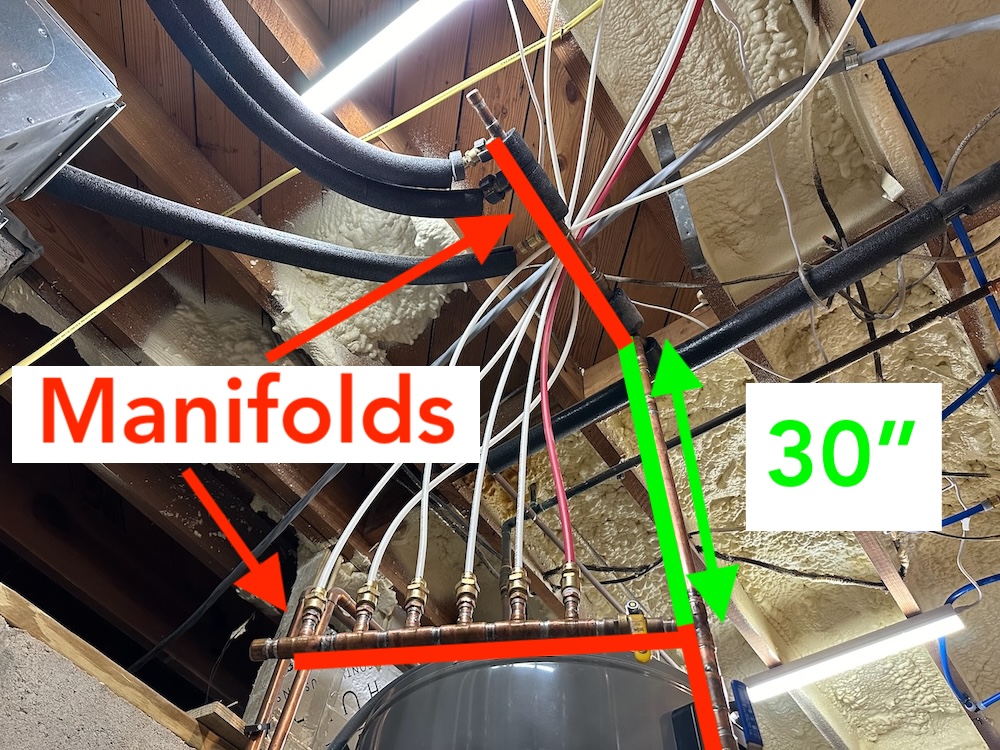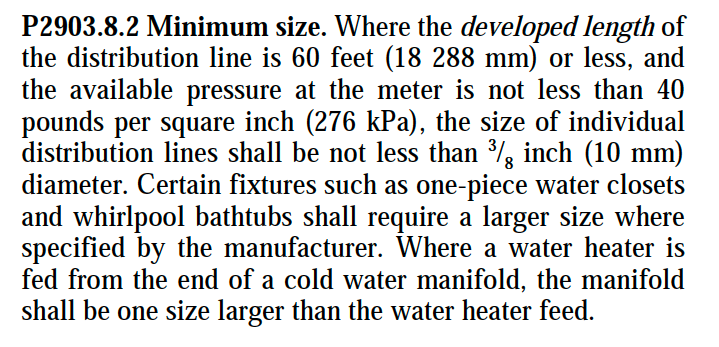An Improved System for Even Faster Hot Water

I missed an opportunity. You may recall the retrofit I did in 2022 to get faster hot water at three of my fixtures. It made a huge improvement, but it could have been even better. But before I go there, let me give you some background information and tell you about the hot water distribution I’ve been working on for my basement renovation. And be sure to watch the video down below, too.
The most common answer isn’t always the best
If you go online and look for information about how to get faster hot water, most of what you’ll find is about recirculating pumps. Yes, they can get you fast hot water, but at a cost. If you go with a pump that keeps the hot water recirculating continuously, you’ll see a significant jump in your energy bills. It takes energy to run the pump, and it also causes the water heater to run more because of the heat loss from the pipes. You can reduce the cost by putting it on a time, but it still can be a lot.
A recirculating pump that operates only on demand is way better. (See the D’MAND pumps and controls for details.) This pump moves the hot water through the system when given the signal to operate. A switch or push button in a convenient place normally is how you make this work, but it could be triggered by a motion sensor as well. The push button type can reduce pump runtime by 98 percent and heat loss by 90 percent compared to a continuous recirculating pump.
But even with the demand type of recirculating pump, you have another mechanical system that uses energy, needs maintenance, and can break down.
The key to faster hot water
The key to faster hot water without having to add more mechanical systems is to get smart about your hot water distribution system. You can see my previous articles on this topic for more details, so I’ll cut to the chase here:
The key to faster hot water is shorter pipes with smaller diameters.
Another way to say the same thing is:
The key to faster hot water is having as little water as possible between the water heater and the tap.
That’s why I changed the hot water distribution for three fixtures in my house in 2022. And it works great! The kitchen faucet, for example, had about 80 feet of mostly 3/4 inch copper pipe It took 2 minutes and 40 seconds to get hot water. Since the retrofit, hot water arrives at the kitchen sink in about 30 seconds. That’s a huge improvement!
But I missed an opportunity because I wasn’t thinking clearly about the whole path of hot water.
My basement hot water improvement
When I did my first retrofit, I made two mistakes. Yes, I did get a lot of improvement by reducing the overall length of the kitchen piping from 80 feet to about 36 feet and the diameter from mostly 3/4 inch to 3/8 inch. But my first mistake was not considering where to insert the manifold into the distribution system. I placed it up high, near the tee that sent the hot water to the other fixtures.

As you can see in the annotated photo above, that location is 30 inches above where I put the new manifold. There’s another almost 30 inches of 3/4 inch copper pipe below the new manifold. For that size pipe, that means there’s an additional cup of water in each of those 30 inch sections. In the 36 feet of 3/8 inch PEX tubing that goes to the kitchen, there’s about 3 cups of water. So I increased the amount of water I have to push out by a third by putting the manifold so high.
The other mistake I made was making the manifold so long. The new manifold is about the same length as the old one, but it has twice as many branches. By putting extra length in the old manifold, I also put extra water in there that had to be pushed through before hot water could arrive.
![Larry Weingarten likes to put the hot water manifold right at the water heater outlet [Photo courtesy of Larry Weingarten]](jpg/hot-water-manifold-top-of-wh-2-med.jpg)
Here’s my video about the my hot water distribution system. It might give you a better idea of what’s going on here:
Caution: Pay attention to pressure drop
Smaller pipes or tubing means higher velocity and more pressure drop. To make this work, you have to know that the pressure drop in your new system won’t be too much. Plumbing codes generally say you need a minimum pressure at the tap of about 20 pounds per square inch (psi). If you’re starting with 40 psi and have a 25 psi drop, you’re not going to be happy with the water coming out.
The good news is that for PEX (and other plastic pipes) you can run the numbers through the Plastic Pipe Calculator to find out how much pressure drop you’ll get. In my longest 1/4″ run, the calculator says I have about a 30 psi pressure drop. Our incoming water pressure is over 100 psi and reduced to 60 psi in the house. (See my last article for more on that.) So, the 30 psi pressure at the tap is fine. And actually, I don’t even notice a difference between the hot water coming through the small tubing and the cold water coming through 3/4″ and 1/2″ copper pipes.
Quarter-inch tubing is NOT for long runs or houses with low incoming pressure. You have to have good pressure, short runs, and low flow rates. It works for single low-flow fixtures up to about 25 feet of length. That’s why for my kitchen and its 36 foot run, I used 3/8″ tubing.
But can it pass a plumbing inspection?
We just had the plumbing rough-in inspection for our basement renovation. Did the inspector approve the quarter inch PEX tubing? If you go through the prescriptive compliance path of the International Residential Code (IRC), it’s not allowed. Here’s the language in the 2021 IRC:

But in this case, our building official approved it. When he saw the white tubing, he asked, “Do you know why the plumber used 3/8″ for the hot water?”
“That’s not 3/8,” I said. “It’s quarter inch.” Then I explained briefly that it was for faster hot water, and he was satisfied with that. I was prepared to explain a lot more but didn’t need to. If that had failed, I would have gotten a letter from a licensed engineer.
There you have it. Shorter, smaller pipes are the key to faster hot water. Pay attention to ALL of the pipes, though. And if you’re going to go with 1/4 inch tubing, be prepared to support your case.
Allison A. Bailes III, PhD is a speaker, writer, building science consultant, and the founder of Energy Vanguard in Decatur, Georgia. He has a doctorate in physics and is the author of a bestselling book on building science. He also writes the Energy Vanguard Blog. For more updates, you can follow Allison on LinkedIn and subscribe to Energy Vanguard’s weekly newsletter and YouTube channel.
Related Articles
Water Heating Is a System, Not Just a Water Heater
Can a Water Heater Last More Than 15 Years?
Comments are welcome and moderated. Your comment will appear below after approval.

I am 100% bought into this thought process. I’m building a custom home now, and even with an excellent builder and a great plumber… it was hard to convey why I wanted a 3/4″ manifold mounted right on top of the water heater with small, independent lines to our fixtures. It’s just such a rare thought process.
In addition, it was hard to find good pre-made commercial product with 3/4″ copper that had the shut-off valves ready to go for PEX tubing. I found some options, but they were either prohibitively expensive or only for PEX-A (or both)… they would have had to custom-build a manifold.
I ended up settling for a man-a-bloc, which I believe are 1 1/4″ inside and which will be further from the heater… I’m not thrilled, but it’s good enough for occupancy. I’ll likely end up pulling it out later.
Mike: If you don’t sweat copper yourself, find someone who does and make your own manifold. It’s not that hard.
Not true. It’s a pia and stupid. Looks like hell and waste of money.
Google “copper manifold”. There are several. SupplyHouse.com has some. BlueRidgeCompany.com has some too. Sioux Chief makes some.
Taco makes the pump for the D’Mand recirculating system. Go direct with the TacoGenie. There are a few others. It is important to plumb it exactly as the instructions say. One could probably cobble together a system. Google “on demand recirculating water” to find cross over valves. Pair that with a recirculating pump with a timer. Disable the timer and put in a switch for on demand.
There is a downside to the manifold close to the tank. I once lived on the top floor of a three story apartment building. If the people in the apartment below me used the hot water while I was showering, I would lose the hot water. The plumber increased the diameter of the pipe running across the basement ceiling and didn’t change the risers. It solved my hot water problem
This might deliver the initial hot water quickly, but can it sustain it for a long hot shower?
Neil: Yes, the duration of a shower depends on how much hot water is available and the flow rate of the shower head. We have an 80 gallon heat pump water heater that has an 89 gallon first hour rating. I could shower a long time if I wanted to.
Gil, yes.
Buyer beware…The fact that this article mentions 1/4″ anything and is not immediately followed by head loss is testament to lack of understanding, well of many things. Sure, you can have hot water faster, but if you have many bit of a long run, you’ll be better off spitting on your hands to clean them. Also, consider the work required, cost of doing it, and the peanuts you’ll save at the hot water heater. Pumps are also silly, and a contractor money grab outside of large systems… Is the money you need to spend on a recirc pump and maintaining it really worth the 5-10 seconds you might have to wait for hot water? Outside of that, yes a manifold is a good idea in some scenarios. If you have two faucets on floor 2 it makes no practical sense to run 2 separate lines, from just about any standpoint, unless you want isolation at the tank.
Jesse: I did caution readers about pressure drop in the video and put a link to the Plastic Pipe Calculator that allows you to find out how much pressure drop you’ll get. Apparently I forgot to put it in the article, too, so thanks for bringing that up. I’ll add it now.
On the video you show the T&P Valve, it this piped to discharge somewhere else?
Would a Convective Heat Loop help in in the delivery of Hot water being at the source for water saving by plumbing into the DHWT drain to loop the hot water back with a check valve letting convection naturally moving thru the system?
David the natural convection method of recirculating used to work pretty well. Sometime ago water heater manufacturers were required to put a device in the hot water outlet that would prevent this. It now no longer works.
Having already laid in the 1″ supply and 3/4″ cold water delivery lines for my Pex retrofit, I started reading about biofilm buildup. I found a couple of studies that show city water treatment with chlorine doesn’t really do anything to stop it and in one study, made it worse. The best way to prevent it seems to be making sure the velocity in the pipes is high.
With very low incoming pressure (~25-30 psi at the basement floor) we use a booster pump and my strategy has been pivoting around optimizing this system with a combination of large and small diameters like Allison. Even with the pump however, the 1″ and 3/4″ won’t have a high enough velocity to scour the pipe walls except when using the tub filler. Now I’m hitting the pause button until I get a little smarter about this.
The code supply fixture units were originated a long time ago and do not account for modern low flow fixtures so the water piping sized based on code is larger than it needs to be. caution should be exercised with velocities in copper hw piping see page 11 in the copper tube handbook (you can download in online for free). I have seen firsthand the erosion in copper pipe and mix it with type M copper and you have a recipe for disaster.
Andrew: Thanks for mentioning that. I wrote about how the evolution of plumbing fixtures from high to low flow and the effect on hot water delivery in this article:
Why Your Hot Water Takes So Long
https://www.energyvanguard.com/blog/why-your-hot-water-takes-so-long/
For those who want to download the free Copper Tube Handbook, here’s the link:
https://copper.org/applications/plumbing/cth/
And for those wondering what type M is, copper pipe for supply plumbing comes in three types: K, L, and M. Type K has the thickest walls and is typically used for underground applications. Type L has the next thickest walls and is best for indoor plumbing. Type M has the thinnest walls and its main advantage is that it’s cheaper.
I would spend a couple of bucks and insulate the copper manifold to stop heat lost.
Will: Aye, that’s going to happen soon.
Just put a temp sensor with timer with recirc pump. Only runs when temp gets below a certain temp, and doesn’t run overnight. Is it perfect? No, but definitely saves on consumption of gas and el.
Then there is always (at an obvious increased cost) the option of on demand water heaters installed at the point of use.
The wait for hot water is negligible, you don’t have a single point of failure with a single hot water heater (so with more than one bathroom you would always have one that works), and no worry of the old “flush while someone is in the shower” problem. It would decrease the amount of plumbing needed, so no heat loss along the way, fewer points to leak, and no tank problems.
Disadvantages being the increased cost, where to put the water heaters and, in my case, solar would be out of the question.
Here in Orlando, I’m keeping my solar.
I’m retrofitting a 1864 brick farmhouse house. I will have a 75ft run from the electric hybrid heat pump water heater in the unheated basement to a mother in-law suite with a full kitchen and bath with a shower. I was planning on running 3/4″ hot and cold pex-a water lines from the basement to the suite. To reduce the cold hot water issue, I was planning on adding a small electric on-demand hot water heater inside of the suite and plumb the 3/4″, 75ft hot water run from the basement into the on demand suite hot water heater. Is there an on-demand hot water heater that will kick on when unheated hot is flowing but turn off when the heated water from basement hybrid water heater finally reaches the on demand suite heater? Is the a good or bad idea? Will this pass code?
It’s my understanding that you aren’t supposed to pipe anything but cold water into an on demand water heater, but I could be wrong. I would contact the manufacturer first before hooking up any variation of that sort.
You can install a 115 volt point of use water heater and just set the thermostat a few degrees lower than the hybrid, that way it shuts off. google this for application info.
BCEE88F0-33E4-4939-B03F-117E983BDE16.pdf
Ask Stiebel-Eltron. My recollection is that I asked that question and they told me the heater would turn off when the hot water reached the on demand heater.